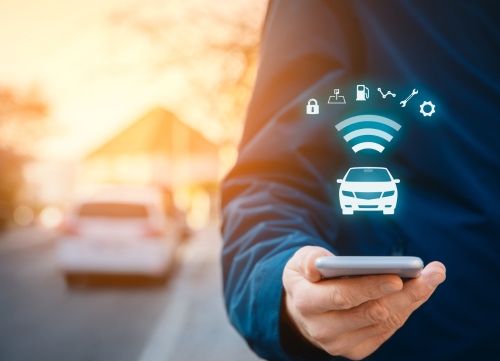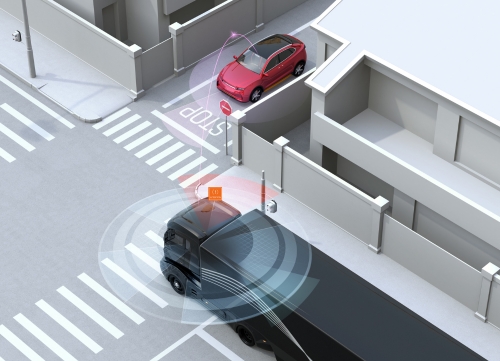In the ever-evolving world of technology, the transportation sector must stay current. One emerging trend that has gained significant attention is the concept of connected fleets. This refers to a group of vehicles, often commercial, interconnected through advanced technological systems, allowing for seamless communication and coordination. A critical component of this modern marvel is vehicle-to-everything (V2X) communication technologies.
In this article, we’ll explain what vehicle-to-everything communication means and touch on the various benefits of V2X for the fleet industry.
V2X communication is an umbrella term that encompasses various forms of vehicle communication systems such as vehicle-to-vehicle (V2V), vehicle-to-infrastructure (V2I), vehicle-to-pedestrian (V2P), and vehicle-to-network (V2N) communications.
The underlying principle behind V2X technology is the seamless exchange of information between a vehicle and its surroundings. This includes everything from other vehicles on the road, traffic lights and signs, to pedestrians, cyclists, and even the internet.
At the heart of V2X communication lies Dedicated Short-Range Communications (DSRC), a wireless communication tech similar to Wi-Fi. DSRC operates in a dedicated spectrum band for automotive use, ensuring reliable, secure, and fast data transmission.
Another critical component of V2X technology is the onboard unit (OBU) installed in vehicles. The OBU can send and receive messages about the vehicle's speed, direction, brake status, etc. These messages are processed and interpreted to inform the driver or the autonomous driving system about potential hazards or changes in traffic conditions.
On the other side is the roadside unit (RSU). These infrastructure devices are deployed along roadsides or in traffic management centres. RSUs communicate with OBUs and other RSUs to relay important information about traffic signals, road conditions, and other critical data.
By enabling vehicles to 'talk' to their surroundings, V2X communication paves the way for safer, more innovative and efficient transportation systems.
The safety impact of V2X for the fleet industry cannot be overstated as it allows vehicles to interact with their surroundings in real-time, offering unprecedented levels of situational awareness.
One of the vital safety features facilitated by V2X is collision warnings. By enabling vehicles to communicate with each other (V2V), a fleet vehicle can receive alerts about sudden stops, lane changes, or other manoeuvres from other vehicles on the road. This can help prevent accidents resulting from blind spots or unexpected traffic situations.
Additionally, V2X technology can communicate with infrastructure (V2I), providing real-time information about traffic signal timings, road conditions, and potential hazards.
It can even provide safety benefits for vulnerable road users such as pedestrians and cyclists (V2P). If a pedestrian steps onto the road unexpectedly, the vehicle can warn the driver or even activate automatic emergency braking.

V2X communication technologies can significantly aid in improving operational efficiency in the fleet industry. Integrating V2X technology with traffic management systems and traffic signal control can lead to more efficient traffic flow, reducing the time spent on the road and consequently lowering fuel consumption.
One of the most apparent benefits of V2X for the fleet industry is improved fuel efficiency. By providing real-time information about traffic conditions, V2X technology enables vehicles to adjust their speed or route to avoid congestion, leading to less stop-and-go driving and more consistent rates, which can significantly reduce fuel consumption.
Another crucial benefit is predictive maintenance. V2X technology allows vehicles to communicate with each other and share information about their condition. This can help identify potential issues before they become serious problems, enabling preventative maintenance and reducing downtime. Not only can this extend the lifespan of the vehicles, but it also ensures they operate at peak efficiency.
Aside from safety and efficiency, the benefits of V2X communication extend to environmental aspects, significantly contributing to a more sustainable future.
The primary way V2X contributes to sustainability is by reducing emissions. This technology provides real-time information about traffic conditions and road infrastructure, enabling fleet vehicles to optimise their routes and avoid congested areas. By helping drivers maintain a consistent speed and eliminate unnecessary stops and starts, V2X plays a crucial role in reducing fuel consumption.
Studies have shown that maintaining a steady driving speed is highly beneficial for lowering fuel use, which in turn reduces carbon emissions. This is key in the fight against climate change, as the transport sector is one of the major contributors to global greenhouse gas emissions.
By lowering emissions, V2X also helps reduce air pollution; a critical issue in urban areas where vehicle emissions significantly impact air quality. This not only helps protect our environment but also contributes to public health.
Adopting V2X technology is not just a smart move for enhancing safety and efficiency in fleet management; it's also a stepping stone towards a more sustainable future.

Discover how SG Fleet is leading the way in fleet innovations, setting new standards for efficiency, safety, and sustainability. With a commitment to pioneering advancements like telematics (such as our in-house solution Motrak), SG Fleet is revolutionising fleet management by providing real-time data on vehicle performance and driver behaviour.
Ready to experience the future of fleet management? Visit our Fleet Solutions and Innovation pages today, or get in touch with our team to learn more about how their innovative solutions can transform your fleet operations. Your journey towards smarter, safer, and more sustainable fleet management starts here!
- From Acquisition to Disposal: Streamlining Fleet Procurement
- Automation in Commercial Driving